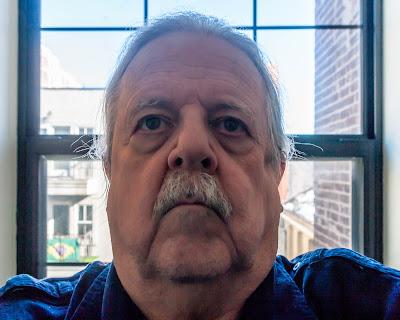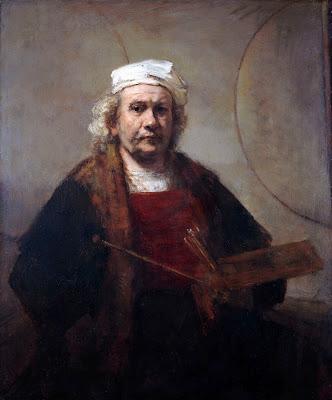Here’s some more selfies.
Though artists have been doing self-portraits for centuries, and people have been using cameras to take pictures of themselves for, I don’t know how long, but I’d guess back into the 19th century, I believe that the term “selfie” is from the smart phone era, though I don’t know that. I assume most selfies are taken to memorialize something, a trip to the State of Liberty, the Great Pyramid, sharing a pizza with a friend, of maybe a quiet moment with your pet cat. Here and there someone is treating the selfie as a medium of self-expression and deliberately experimenting with it. But I’d think that’s relatively rare.
Anyhow, I’m treating it as a medium of self-expression. I used my point-and-shoot camera, a Panasonic DMC-ZS7, to take my earlier selfies. I’ve used my Pentax K-7 to take the photos below. It’s a Pentax D-7, which is a DSLR. It’s considerably heavier than the Panasonic and so shaped that it’s almost impossible to hold it in my right hand when taking the photo. The process is thus more awkward.
Since I can’t see myself while taking the shot I cannot compose it. I just click the shutter and hope for something usable. That is to say, between cropping and adjusting the image in various ways, can I make something of it? That’s an interesting process and is one of the reasons I’m doing this.
Here's six recent shots. I’ve numbered them for reference.
ONE

TWO

THREE

FOUR

FIVE

SIX

My first observation is that I can’t, or anyhow I don’t, treat the background as a neutral backdrop whose main purpose is to disappear and thus to present the subject, my face in this case. The relationship between the face and the background is more active. Though my dominates all of these images except TWO, it doesn’t complete efface the background. The second image is rather different. Most of my body is reflected in the mirror, making my face a rather small part of the image. In a sense, it’s the mirror that’s the foreground subject, but only in a sense. The image is still an image of me, me taking a photo.
Now look at these two self-portraits by Rembrandt, who painted many of them throughout his career.

Rembrandt, Public domain, via Wikimedia Commons

Rembrandt, Self-Portrait with Two Circles
In the first upper one Rembrandt is just left of center and the background is neutral, but so dark that it blends with the image. In the lower one Rembrandt is more visibly to the left of center and the background is a bit lighter. Notice the two circles in the background. The composition would be a bit off kilter without them. The right-hand circle balances the portrait while the mostly-covered left-hand circle answers it.
What was he thinking while doing this? You take a photograph in an instant. Not so with painting a portrait. You must position yourself in front of a mirror and look back and forth between the image you see in the mirror and the image materializing on the canvas. How do you control your facial expression? How do you keep it constant from beginning to end? Or do you? What are you thinking?
As for me, yes, I do think about my facial expression as I take the selfie. But I also must think about just where the camera is, where it’s pointing, snapping the shutter, all of which are more difficult with the heavier and more awkward K-7. Thus it is a bit difficult for me to worry too much about what my face it up to.
There’s a sense is which the exercise is alienating, but I don’t like the negative connotations of the word. Bertolt Brecht’s word, Verfremdungseffekt, is better. It translates as “distance effect.” “Distance” is much better. Distancing, I’m distant from myself. My face becomes the face, visual material in the image, just like the background.
I took the first picture in my work area, the second in a bathroom. I was standing on the landing of a stairwell for the third, with a window behind me. Now, FOUR, I’m walking down a hall, snapping pictures as I can, giving hardly a thought to my facial expression since moving the camera around and snapping the shots consumes my attention. I like the lights, and the tilt. In FIVE I’ve turned a corner and have positioned myself in front of a window, different from the one in THREE. What I like about this one is the way the light washes out the walls of the building we see through the window so that all we can see are windows. In SIX, same stretch of hall, different window. Now we see the building behind me through that window.
More later.

